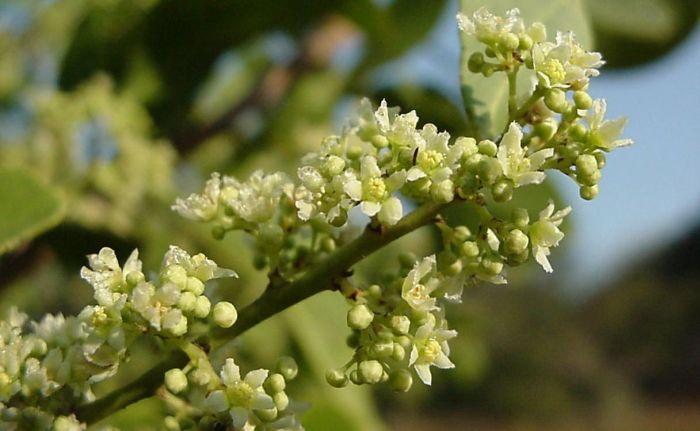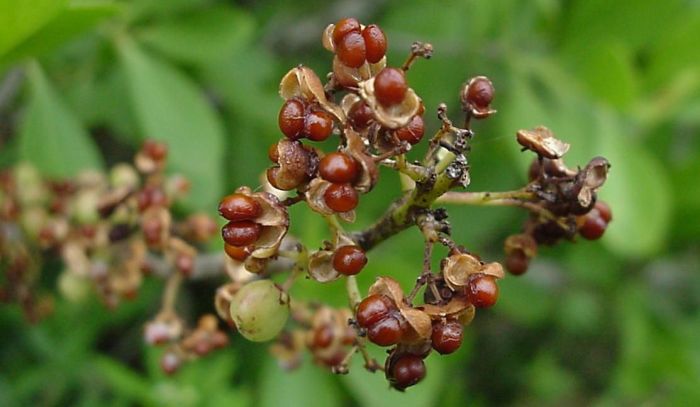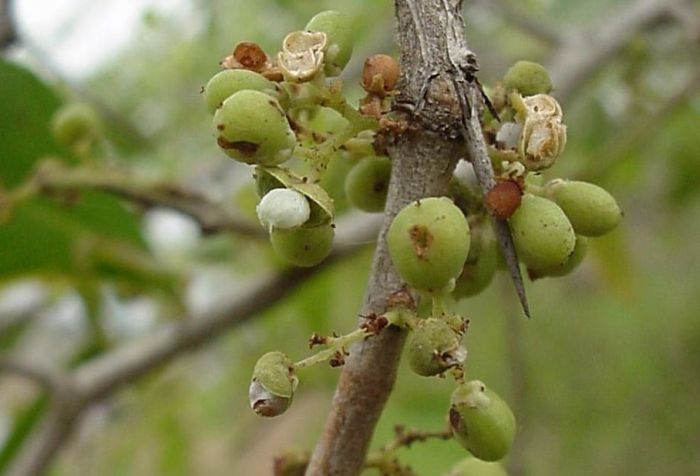Gymnosporia senegalensis
Gymnosporia senegalensis (Lam.) Loes
Family: Celastraceae
Common names: red spikethorn, confetti spikethorn (Eng.); bloupendoring, rooipendoring (Afr.); sephatho, mophatho (Sepedi); sihlangu lesimhlophe (siSwati); ubuhlangwe, isihlangu, isihlangwane (isiZulu); xihlangwa (Xitsonga).
SA Tree No: 402
Introduction
A bright, white-flowered, sweet-scented indigenous shrub, often with wine-red branches. Its roots and leaves are used in traditional medicine to treat various human ailments such as diarrhoea, tuberculosis, pneumonia, asthma, venereal diseases and snake bites.

Description
Description
Gymnosporia senegalensis is a multi-stemmed, much-branched shrub about 4 m tall, or small tree, up to 15 m high. The branches are often wine-red, with slender spines up to 70 mm long. The leaves are clustered, elliptic to obovate, 20–125 × 4–80 mm, leathery, pale blue-green with a whitish bloom, hairless; margin with numerous closely spaced regular rounded teeth.

The flowers are small, cream-coloured or greenish white, sweetly scented, borne in many-flowered axillary heads in winter and spring (June to October). The fruit is a globose capsule, about 5 mm in diameter, smooth, pinkish to reddish; seeds reddish brown, partially covered by a white or pinkish aril.

It can easily be confused with G. glaucophylla, but the latter can be differentiated by its fine grained and yellow wood.
Conservation Status
Status
According to Raimondo et al. (2009), Gymnosporia senegalensis is Red Listed as Least Concern (LC), as evaluated against the five IUCN criteria.
Distribution and habitat
Distribution description
Gymnosporia senegalensis is widespread, occurring mostly in bushveld, along rivers and dry riverbeds, also in grassland, coastal and dune bush. Its distribution ranges from KwaZulu-Natal in South Africa to Namibia and northwards throughout Africa, Europe, and the central and southern part of Asia. It is also found in Madagascar, Mauritius and Seychelles.

Derivation of name and historical aspects
History
The name Gymnosporia is derived from the Greek word, gymnos, meaning ‘naked’ and spora meaning ‘seed’; it refers to the seeds that remain attached and are naked or exposed when the fruit capsules split open. The specific name senegalensis means ‘from Senegal’.
Ecology
Ecology
The red spikethorn is a larval food plant for the butterflies Charaxes jasius saturnus, C. castor flavifascianthus, C. cithaeron cithaeron and Hypolycaena philippus philippus. Flies and butterflies are attracted to the flowers. Monkeys eat the new shoots and leaves. Birds eat the fruits. Black Rhino eat the bark and leaves.

Uses
Use
The red spikethorn is as an important plant in traditional medicine. African traditional practitioners uses its root , stem bark and leaves to treat various ailments, including malaria rheumatism, fever, chest pains, tuberculosis, bronchitis, wounds, chronic illness, dyspepsia eye infection, earache, headaches, epilepsy, diarrhoea, measles, abdominal pains, dysmenorrhoea, uterine cramps, venereal disease, snake bites and also as an aphrodisiac.
The leaf and root are used by the Bapedi traditional healers to treat impotence and diarrhoea. The plant parts used are boiled for about 5–20 minutes and the extract is taken orally three times a day until the diarrhoea stops. In Togo, the roots are used to treat asthma and coughs. In Zimbabwe, the powdered root or infusion is taken orally for the treatment of coughs, bronchitis, pneumonia and tuberculosis. The root infusion is also taken for heavy menstruation and uterine cramps, and to prevent an incipient abortion. In India, the leaves are used to treat toothaches.
In Limpopo Province, the plant is also used to prevent diarrhoea in ruminant livestock. Furthermore, the livestock farmers use it to stop bleeding and treatment of wounds in animals that were attacked by predators.
The wood is hard, yellowish white and is used for sticks and to start fire by friction.
Growing Gymnosporia senegalensis
Grow
In its natural habitat, Gymnosporia senegalensis is a moderate grower. Currently, there is no evidence of this species being cultivated in gardens. Users of this plant usually harvest it from the wild.
References
- Boon, R. 2010. Pooley's trees of eastern South Africa, a complete guide. Flora & Fauna Publications Trust, Durban.
- Clarke, H. & Charters, M. 2016. The illustrated dictionary of southern African plant names. Flora & Fauna Publications Trust, Jacana, Johannesburg.
- Da Silva, G., Serrano, R. & Silva, O. 2011. Maytenus heterophylla and Maytenus senegalensis, two traditional herbal medicines. Journal of Natural Science, Biology and Medicine 2(1): 59–65.
- De Wet, H., Nkwanyana, M.N. & Van Vuuren, S.F. 2010. Medicinal plants used for the treatment of diarrhoea in northern Maputaland, KwaZulu-Natal, South Africa. Journal of Ethnopharmacology 130: 284–289.
- Kpoyizoun, K.P. et al. 2019. Effect of Maytenus senegalensis roots on OVA-induced airways inflammation in a mouse asthma model. African Journal of Pharmacy and Pharmacology. 13(5): 49–56.
- Makgatho, M.E. et al. 2018. Anti-mycobacterial, -oxidative, -proliferate and –inflammatory activities of dichloromethane leaf extracts of Gymnosporia senegalensis (Lam.) Loes. South African Journal of Botany 114: 217–222.
- Mathabe, M.C. et al. 2006. Antibacterial activities of medicinal plants used for the treatment if diarrhoea in Limpopo Province, South Africa. Journal of Ethnopharmacology 105: 286–293.
- Matlebyane, M.M. et al. 2010. Indigenous knowledge ranking of available browse and grass species and some shrubs used in ruminant livestock production in Limpopo, South Africa. Livestock Research for Rural Development. Volume 22.
- Raimondo, D., Von Staden, L., Foden, W., Victor, J.E., Helme, N.A., Turner, R.C., Kamundi, D.A. & Manyama, P.A. (eds) 2009. Red list of South African plants. Strelitzia 25. South African National Biodiversity Institute, Pretoria.
- Schmidt, E., Lötter, M. & McCleland, W. 2002. Trees and shrubs of Mpumalanga and Kruger National Park. Jacana, Johannesburg.
- Semenya, S.S. & Maroyi, A. 2012. Medicinal plants used by the Bapedi traditional healers to treat diarrhoea in the Limpopo Province, South Africa. Journal of Ethnopharmacology 144: 395–401.
- Semenya, S. et al. 2013. Herbal medicines used by Bapedi traditional healers to treat reproductive ailments in the Limpopo Province, South Africa. African Journal of Traditional, Complementary Alternative Medicines 10(2): 331–339
- Van Wyk, B. & Van Wyk, P. 2013. Field guide to trees of southern Africa. Struik Publishers, Cape Town, Johannesburg.
- Van Wyk, B.-E. & Gericke, N. 2000. People's plants, a guide to useful plants of southern Africa. Briza Publications, Pretoria.
Credits
M.S. Mothogoane
National Herbarium, Pretoria
January 2021
Acknowledgements: photos by Geoff Nichols.
Plant Attributes:
Plant Type: Shrub, Tree
SA Distribution: KwaZulu-Natal, Limpopo, Mpumalanga
Soil type: Sandy, Loam
Flowering season: Spring, Early Summer, Winter
PH: Acid, Alkaline, Neutral
Flower colour: White, Cream
Aspect: Full Sun
Gardening skill: Average
Special Features:
Horticultural zones








Rate this article
Article well written and informative
Rate this plant
Is this an interesting plant?
Login to add your Comment
Back to topNot registered yet? Click here to register.